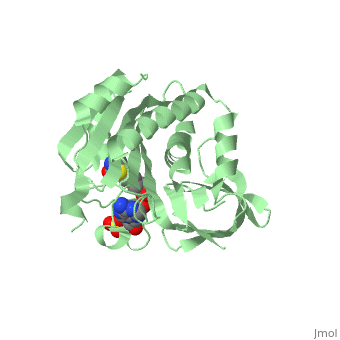4op0: Difference between revisions
No edit summary |
No edit summary |
||
| Line 18: | Line 18: | ||
</div> | </div> | ||
<div class="pdbe-citations 4op0" style="background-color:#fffaf0;"></div> | <div class="pdbe-citations 4op0" style="background-color:#fffaf0;"></div> | ||
== References == | == References == | ||
<references/> | <references/> | ||
Revision as of 11:28, 22 November 2017
Crystal structure of biotin protein ligase (RV3279C) of Mycobacterium tuberculosis, complexed with biotinyl-5'-AMPCrystal structure of biotin protein ligase (RV3279C) of Mycobacterium tuberculosis, complexed with biotinyl-5'-AMP
Structural highlights
Publication Abstract from PubMedProtein biotinylation, a rare form of post-translational modification, is found in enzymes required for lipid biosynthesis. In mycobacteria, this process is essential for the formation of their complex and distinct cell wall and has become a focal point of drug discovery approaches. The enzyme responsible for this process, biotin protein ligase, substantially varies in different species in terms of overall structural organization, regulation of function and substrate specificity. To advance the understanding of the molecular mechanism of biotinylation in Mycobacterium tuberculosis we have biochemically and structurally characterized the corresponding enzyme. We report the high-resolution crystal structures of the apo-form and reaction intermediate biotinyl-5'-AMP-bound form of M. tuberculosis biotin protein ligase. Binding of the reaction intermediate leads to clear disorder-to-order transitions. We show that a conserved lysine, Lys138, in the active site is essential for biotinylation. Active site conformational changes upon reaction intermediate biotinyl-5'-AMP binding in biotin protein ligase from Mycobacterium tuberculosis.,Ma Q, Akhter Y, Wilmanns M, Ehebauer MT Protein Sci. 2014 Apr 9. doi: 10.1002/pro.2475. PMID:24723382[1] From MEDLINE®/PubMed®, a database of the U.S. National Library of Medicine. References
|
| ||||||||||||||||||||
